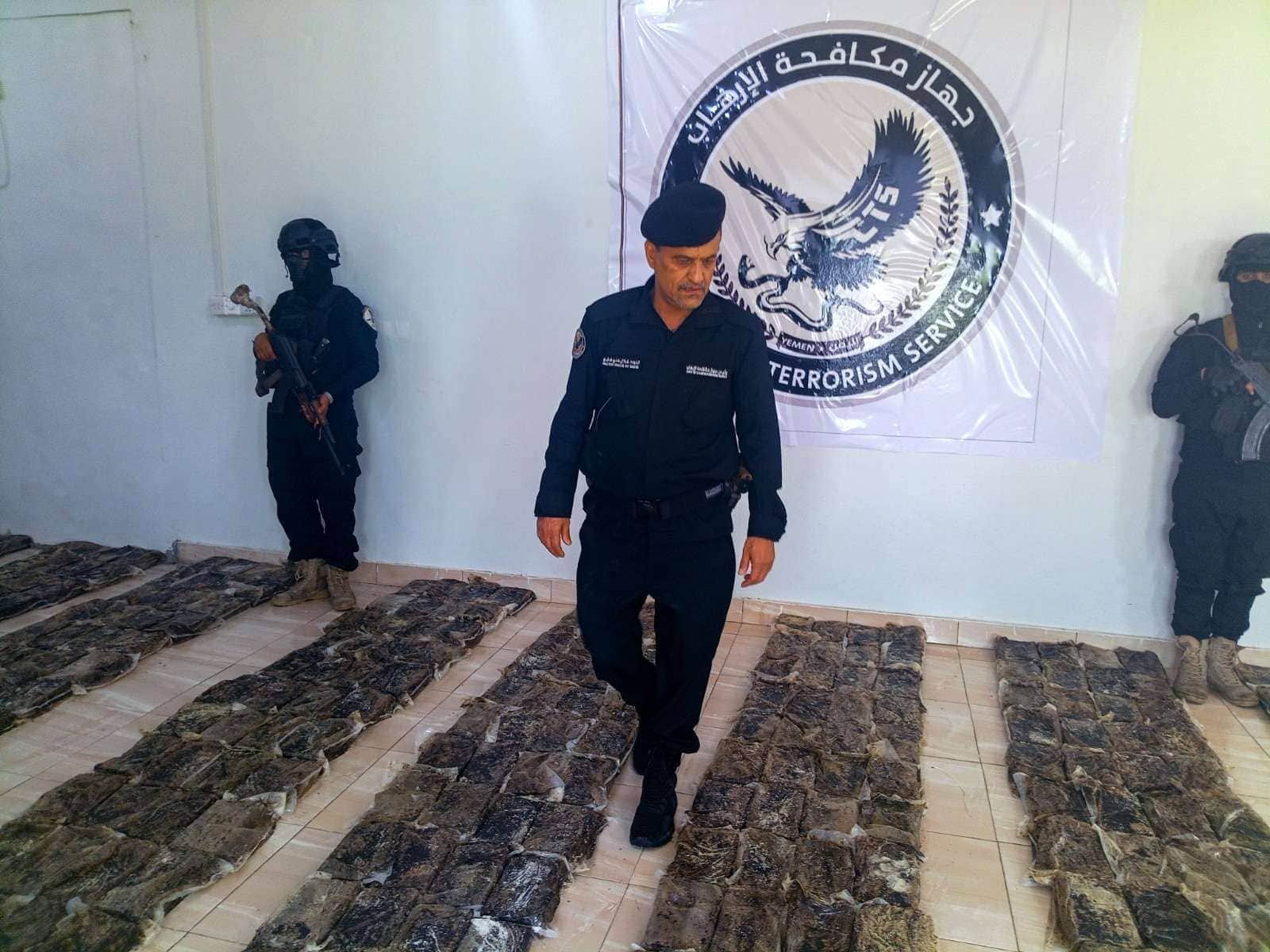
Aden: A cocaine shipment, concealed inside sugar bags, being smuggled from Brazil to the Houthis was intercepted and seized on August 23, 2025 (Counterterrorism Service Media)
آخر تحديث في: 22-09-2025 الساعة 12 مساءً بتوقيت عدن
|
|
"The Houthis are attempting to replicate the Syrian–Lebanese model in Yemeni territory, which poses a direct threat to the national security of Aden and the South"
Abdullah Al-Shadli (South24 Center)
Yemen has been witnessing a troubling escalation in drug trafficking and manufacturing activities for months now, to the point that it can no longer be described as isolated incidents or a passing trade. The massive quantities seized, along with the discovery of the country’s first fully integrated factory for producing Captagon and crystal meth, reveal a qualitative shift that positions Yemen as an emerging hub. This transformation parallels—in its structure and severity—the model established by the Assad regime in Syria and Hezbollah in Lebanon over the past decade, before both networks were hit by security and military operations that curbed their ability to continue.
With mounting evidence of Houthi involvement, strategic questions arise regarding the nature and background of the project underway. It appears to go beyond the immediate economic motive of funding the war, evolving into a political and security tool aimed at flooding communities with drugs, destabilizing the region, and forging new networks of influence.
The recent wave of security seizures in southern governorates between June and September 2025 provides the clearest indicator of this shift. Authorities intercepted unprecedented shipments of Captagon, crystal meth, cocaine, and hashish—some concealed using sophisticated methods, others produced locally in labs linked to the Houthis.
Figures and Seizures
The past months have seen a series of security operations that have revealed a qualitative shift in Yemen’s drug landscape. On September 4, security forces in Al-Mahra announced the seizure of the country’s first fully integrated factory for producing Captagon and crystal meth, with an estimated output of 45,000 pills per hour. The facility was operated by a network linked to the Houthis, comprising Yemenis and other Arab nationals.
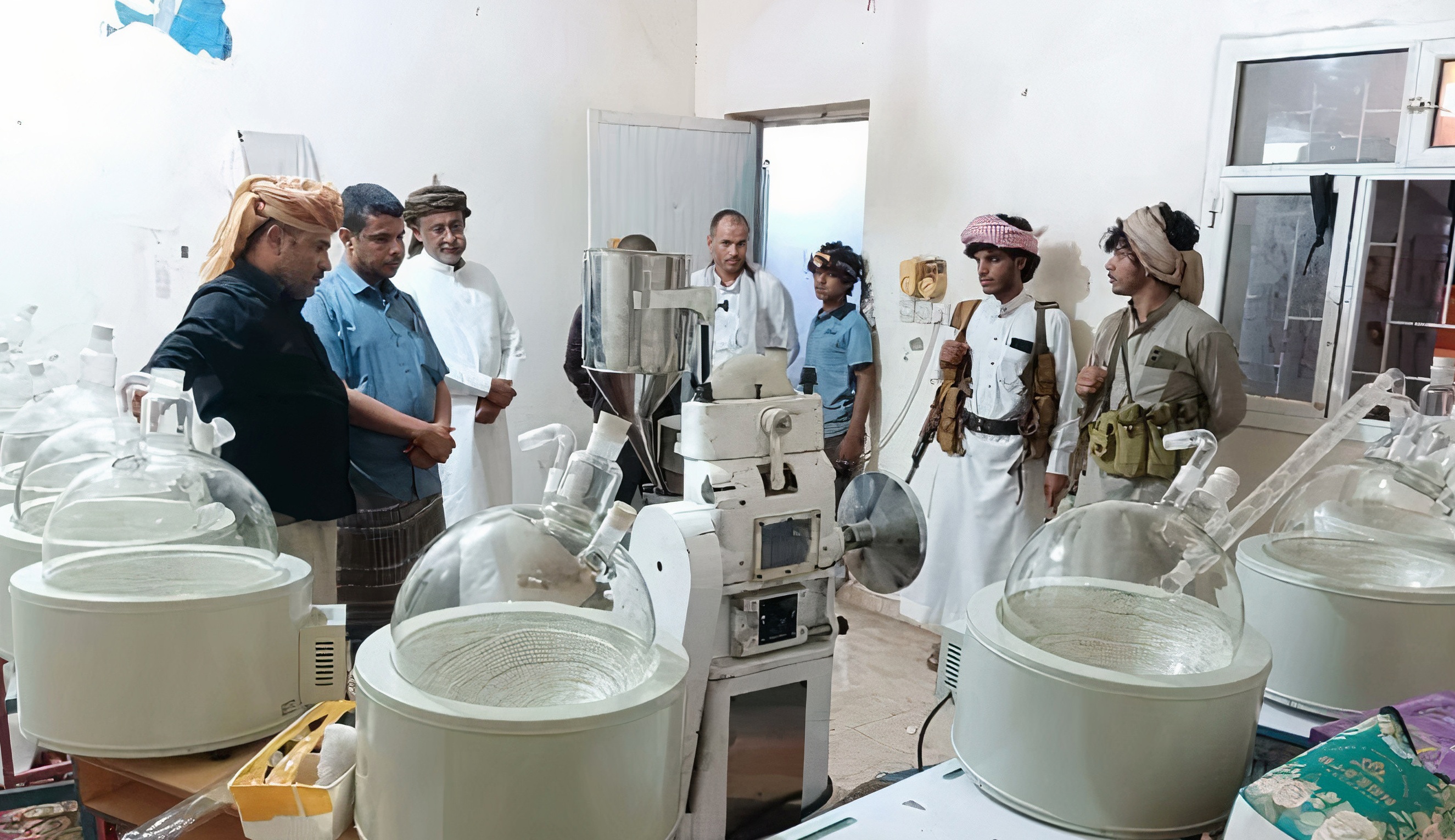
Al-Mahra Police foiled an attempt to set up a Captagon and crystal meth factory with the seizure of a modern lab and the arrest of six suspects – September 4, 2025 (Security Media)
In late August, authorities in Aden seized 599 kilograms of pure cocaine hidden in a shipment of sugar arriving from Brazil and destined for Houthi-controlled areas. During the same period, the criminal prosecution office destroyed more than 657 kilograms of narcotics seized in separate operations.
In June, border authorities thwarted an attempt to smuggle approximately 1.5 million narcotic pills from Sana’a toward Saudi Arabia via the Al-Wadiah land crossing. Additional seizures in Lahj, Aden, and the Red Sea governorates included large quantities of hashish, crystal meth, and heroin.
The attached table outlines the scale of these seizures, totaling over 2.4 million narcotic pills and nearly 1.5 tons of solid substances, distributed among hashish, crystal meth, cocaine, and heroin.
|
Drug Seizures (June – September 2025) in areas
under the control of the internationally recognized Yemeni government – Based
on official data – South24 Center |
||||||
|
No. |
Date of Announcement |
Main Type |
Quantity (Tablets) |
Quantity (Kg) |
Source |
Seizure Location |
|
1 |
11/06/2025 |
Narcotic tablets + Hashish + Shabu |
1,546,798 |
504 |
Sana'a City |
Al-Wadia Land Port |
|
2 |
24/06/2025 |
Pregabalin tablets |
646,290 |
- |
Coastal smuggling |
Aden |
|
3 |
29/06/2025 |
Hashish |
- |
500 |
Coastal smuggling |
Lahj |
|
4 |
30/06/2025 |
Shabu + Heroin + Hashish |
- |
447 |
Coastal smuggling |
Lahj |
|
5 |
06/07/2025 |
Captagon |
13,750 |
- |
Sana'a |
Al-Wadia Land Port |
|
6 |
17/07/2025 |
Captagon |
15,920 |
- |
Houthi areas |
Al-Wadia Land Port |
|
7 |
23/08/2025 |
Pure Cocaine |
- |
599 |
Incoming shipment [Brazil] |
Aden |
|
8 |
26/08/2025 |
Captagon |
150,000 |
- |
Coastal smuggling |
Lahj |
|
9 |
29/08/2025 |
Pregabalin |
28,500 |
- |
Coastal smuggling |
Lahj |
|
10 |
04/09/2025 |
Captagon and Shabu Factory |
- |
- |
- |
Al-Mahra |
|
11 |
04/09/2025 |
Shabu |
- |
432 |
Coastal smuggling |
Red Sea (Mokha) |
|
Total: 2,401,258 tablets + 2.48 tons |
||||||
|
Source: Official Security Departments, Saba News
Agency, Official Pages |
||||||
|
|
||||||
Experts and officials interviewed by ‘South24 Center’ believe that the collapse of the drug trade network once sponsored by the Assad regime in Syria and Hezbollah in Lebanon has prompted a search for alternatives. Given Yemen’s fragile security situation and its strategic location overlooking the Red Sea, Gulf of Aden, and Bab al-Mandab, the country has become an ideal environment for relocating this industry.
In this context, Brigadier General Abdullah Lahmadi, head of Yemen's anti-narcotics department, stated that what is happening “is no longer mere cross-border smuggling, but an organized project to flood the region with narcotics, managed by the Houthi militia with direct support from the Iranian regime.” He told ‘South24 Center’ that the recent seizures “reflect a qualitative shift in smuggling and manufacturing methods, especially following the discovery of the first fully integrated Captagon factory in Al-Mahra.”
Lahmadi noted that the security operation there “lasted a full week of surveillance and led to the arrest of six Yemenis linked to the Houthis, along with Arab experts previously apprehended in Aden and Al-Mahra.” He cited confirmed reports of “active drug factories in Houthi-controlled areas”, making Yemen “a primary destination for drug production and trafficking gangs following the decline of operations in Syria and Lebanon”.
For his part, Major General Mutahar Al-Shaeebi, Aden’s Police Chief, revealed the arrest of Syrian national Ali Hassan Al-Ahmad, known as “Abu Hassan”, who was involved in drug factory operations in Al-Mahra and Al-Mahweet. He explained that investigations “uncovered a Captagon production facility in Al-Mahweet modeled after the system inherited by the Houthis from the Assad regime”.
Al-Shaeebi added in his statement to ‘South24 Center’ that the group “is attempting to replicate the Syrian–Lebanese model in Yemeni territory, which poses a direct threat to national security.” He confirmed that drugs originating from Houthi areas “are spreading at unprecedented rates among youth in Aden and other southern regions,” noting that many cases have been referred for treatment or prosecution.
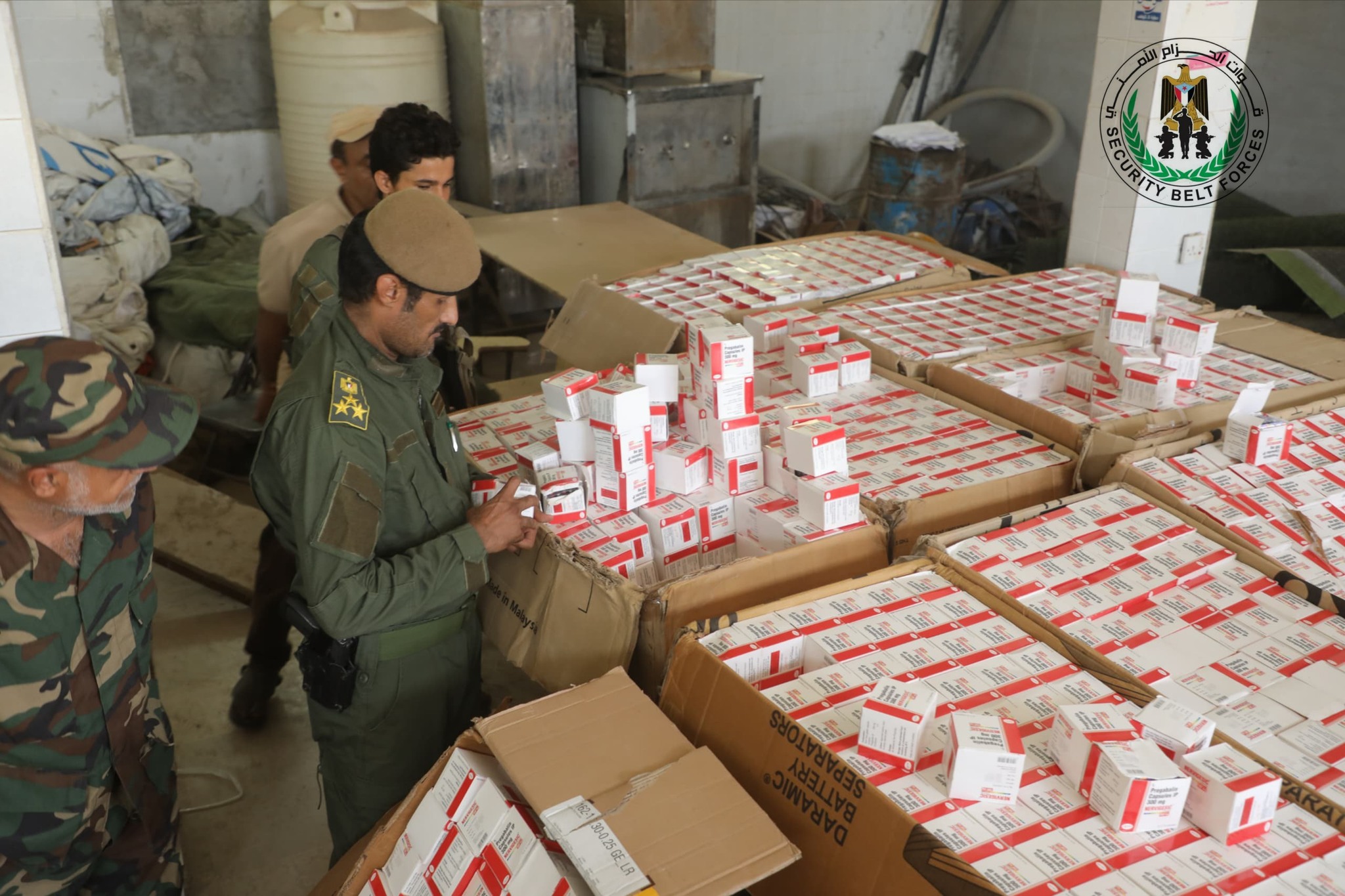
Security Belt Forces in Aden seized 646,000 Pregabalin pills on June 24, 2025 (Security Belt Media)
Al-Shaeebi also spoke of intensive coordination efforts with security and military agencies in government-controlled areas, including the Security Belt Forces and the Counterterrorism Unit, as well as cooperation with the judiciary. However, he emphasized the “major challenges facing these efforts, particularly with regard to smuggling through land and sea crossings, which often intersect with arms and human trafficking operations from the Horn of Africa or Houthi-controlled regions.”
Smuggling Routes
Drug smuggling routes across Yemen reflect the scale of organized networks. Some shipments arrive from abroad, such as the cocaine shipment from Brazil via Aden Port, while others are produced locally in domestic factories, like the one seized in Al-Mahra or the suspected facility in Al-Mahweet in northern Yemen.
Brigadier General Lahmadi clarified that “most of these shipments were destined for neighboring countries, especially Saudi Arabia and Egypt,” stressing that “Yemen has become a primary target for transforming it into a corridor and manufacturing hub for these toxins.”
Major General Al-Shaeebi confirmed that the main smuggling routes include the Red Sea, Bab al-Mandab, and land crossings toward Saudi Arabia, often using civilian freight trucks or fishing boats. He said: “Investigations revealed that many of these shipments are routed through Oman, passing through Al-Mahra before reaching markets in Saudi Arabia and other countries.”
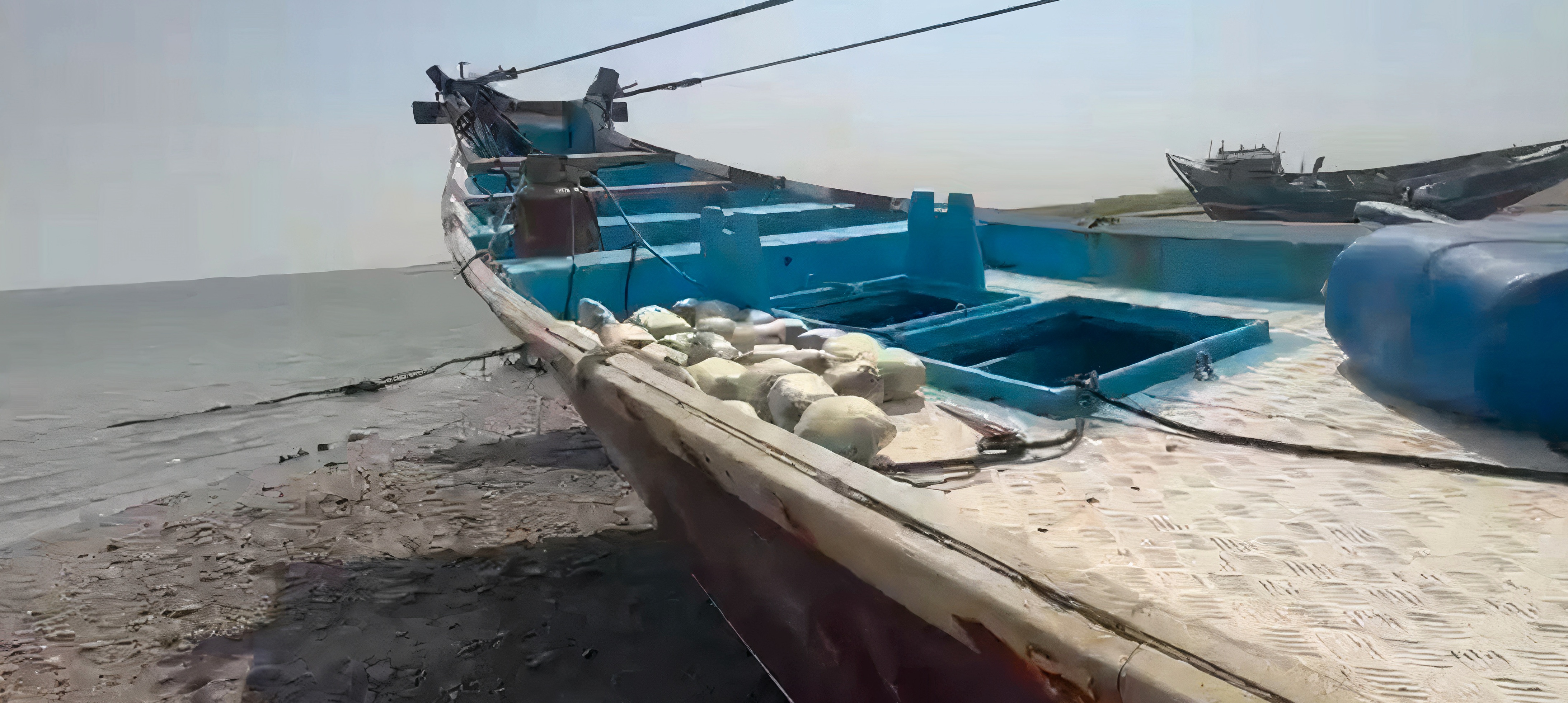
A joint security campaign in Lahj seized a boat near Bab al-Mandab carrying 150,000 Captagon pills and arrested three smugglers on August 26, 2025.
Houthi Objectives
Dr. Saeed Al-Jamhi, an expert on armed groups, believes that the Houthis’ connection to drug networks “is no longer a matter of speculation or hypothetical—it has become a tangible reality.” He explained that the group, like other terrorist organizations, “uses any means to achieve its military and political goals, including narcotics.”
Al-Jamhi told ‘South24 Center’ that the Houthis exploited the security and economic chaos to turn Yemen into “an open drug market, where narcotics are sold at the lowest prices to facilitate their spread among youth and recruit them”. He pointed out that smuggling networks originate primarily from Tehran and reach Yemen through channels operated by influential Houthi leaders, confirming that these gangs “operate under direct protection of the Houthis”.
He noted that the drug trade has become “a primary source of rapid wealth” for the group, and the resulting funds have enabled them to “recruit thousands of fighters, including youth, women, and children, and deploy them to battlefronts”.
Risks and Implications
The impact of this trade extends beyond security and economic dimensions—it threatens Yemen’s social fabric. Brigadier General Lahmadi stressed that “the spread of narcotics threatens society from within, increases addiction and crime rates, and creates additional challenges for the state and community.”
Major General Al-Shaeebi noted that “security forces have recorded numerous cases across Aden’s districts, a dangerous indicator of how deeply these toxins have infiltrated society.” He added that this spread “represents a deliberate scheme targeting the South’s stability and undermines Yemeni–Gulf relations, especially since Saudi Arabia and Egypt are among the primary targets of the smuggling operations.”
Al-Jamhi warned that this trade “enhances the Houthis’ regional influence and grants them a network of power aligned with Iran’s axis, threatening Arab national security as a whole.”
Given the gravity of the challenge, security agencies are intensifying efforts to confront it. Brigadier General Lahmadi affirmed that the ministry “will confront these threats decisively, by strengthening security and military coordination and enhancing cooperation with our partners in neighboring countries.”
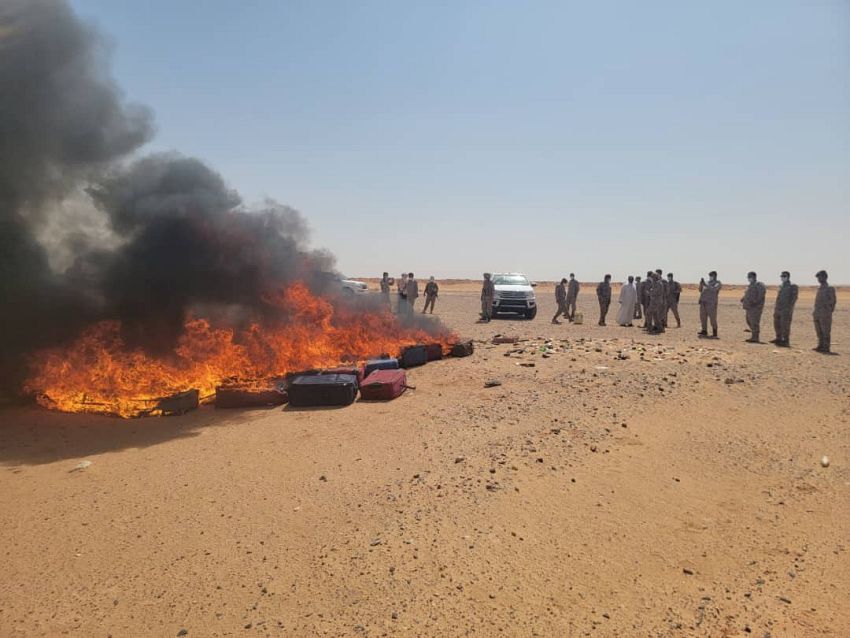
Destruction of narcotics seized at Al-Wadiah land crossing between Yemen and Saudi Arabia – Saba News Agency
Major General Al-Shaeebi emphasized the need for “greater support in terms of equipment and modern technologies, including advanced detection and analysis devices and drones to monitor smugglers’ movements.” He stressed that addressing the phenomenon “is not solely a security matter—it requires the combined efforts of families, civil society, and the media.”
Al-Jamhi pointed out that “failure to contain this phenomenon would leave Yemen hostage to an international network linked to the Houthis and Iran, significantly escalating long-term security and economic challenges.”
The recent security seizures and accompanying intelligence reports reveal signs of a qualitative shift in Yemen’s drug landscape. The mounting evidence of Houthi involvement and their ties to regional networks backed by Iran, places the country before a new reality reminiscent of the experience witnessed in Syria and Lebanon over the past decade.
However, Yemen’s unique context—marked by fragile security, vast geography, and open borders—makes this phenomenon more complex and far-reaching.
Thus, the pressing question remains: Have the Houthis inherited the drug industry from the Assad regime and Hezbollah, or are they in the process of developing their own version within Yemen? The final answer may require more time and evidence, but what is certain is that the continuation of this industry without effective confrontation will exacerbate the security, social, and economic challenges in Yemen and the wider region alike.